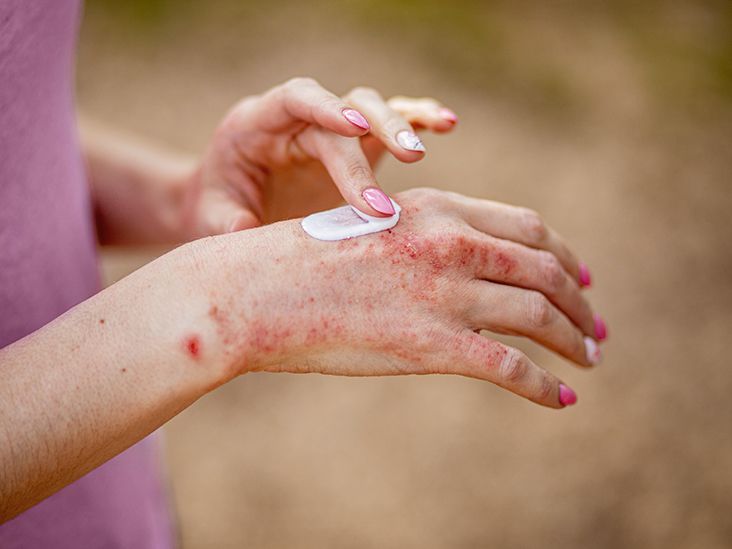Psoriasis is a skin condition that causes discolored, scaly patches. It can occur anywhere on the body, but most often around the knees and elbows.
You can develop psoriasis at any age, but most often around 15 to 25 years old. It’s rare for children under 10 to have the condition.
Psoriasis isn’t transmissible and can appear in different forms. One of these forms is pustular psoriasis, which produces white, noninfectious pus-filled blisters (pustules). It’s very rare, affecting only about
Pustular psoriasis can happen in conjunction with other forms of psoriasis, like plaque psoriasis. It can break out in single areas, like the hands and feet, or all over the body. It’s rare to develop it on the face.
It usually begins with an area of skin becoming tender and discolored. Within a few hours, the telltale large blisters of noninfectious pus form. Eventually, these blisters turn brown and crusty. After they peel off, skin can appear shiny or scaly.



Pustular psoriasis isn’t a typical skin rash. Visit a doctor if you notice unusual skin changes or a rash, blister, or open sore that doesn’t improve or worsens.
To diagnose pustular psoriasis, a doctor may perform a complete blood count to check for signs of elevated inflammation and abnormalities in your white blood cells (WBCs). If you have pustular psoriasis, your blood test results may show a reduced amount of lymphocytes, a type of WBC.
Sometimes, doctors will remove and examine a sample of a pustule to diagnose the condition.
There are multiple types of pustular psoriasis.
von Zumbusch pustular psoriasis
von Zumbusch psoriasis, or acute generalized pustular psoriasis, is the most severe type of pustular psoriasis. It’s very rare.
It begins with painful areas of skin and has a rapid onset, generally developing within 7 days or less. Pustules form within hours and dry up in 1 or 2 days.
von Zumbusch psoriasis can recur in cycles, returning every few days or weeks. It’s
Symptoms may include:
- severe itching
- fever
- rapid pulse rate
- muscle weakness
- anemia
- chills
- dehydration
This condition requires immediate medical care. Over time, von Zumbusch psoriasis can cause weight loss and exhaustion.
Potential complications include hair and nail loss, secondary bacterial infection, and liver damage.
This type of pustular psoriasis can have life threatening complications, such as respiratory and heart failure, sometimes resulting in death. The condition has a mortality rate of 2% to 16%.
Palmoplantar pustulosis (PPP)
Palmoplantar pustulosis (PPP) is also called localized pustulosis. This type of pustular psoriasis forms on the:
- palms of the hands, often at the base of the thumb
- soles of the feet
- sides of the heels
The pustules begin on top of red patches of skin and later turn brown, peel off, and form a crust. This condition is rare, so there’s not much evidence on how these pustules may appear on skin of color. In general, psoriasis may look more purple on darker skin tones. The person may also have more hyperpigmentation.
As with von Zumbusch psoriasis, PPP can come and go in cycles, leaving the skin with a rough, cracked appearance. People who smoke have a higher incidence of PPP than nonsmokers.
Symptoms may include:
- itching
- pain
- a burning sensation in your hands and feet
- difficulty walking and performing tasks using your hands
Acropustulosis
Acropustulosis, also called acrodermatitis continua of Hallopeau (ACH), is a rare type of pustular psoriasis. It’s clearly identifiable by the painful skin lesions that form on the ends of fingers and toes. When the pustules burst, they leave bright, scaly patches that can ooze.
The
Acropustulosis is sometimes confused with hand, foot, and mouth disease (HFMD). Unlike HFMD, acropustulosis doesn’t present with a fever or sore throat.
Experts aren’t sure of the exact cause of psoriasis, but they know that the immune system plays a role.
Several things may trigger psoriasis or increase your risk of developing it. Pustular psoriasis triggers include:
- emotional stress
- pregnancy
- skin injury
- infection
- exposure to certain metals or chemicals
- overexposure to UV light
- coal tar, which is part of some natural psoriasis treatments
- medications
Medications
Certain drugs may also trigger pustular psoriasis. These include topical medications and systemic medications like corticosteroids. Flare-ups usually start about 2 to 3 weeks after you begin using the drug.
Pustular psoriasis can also develop by rapid withdrawal from topical or systemic corticosteroids like prednisone (Rayos). Prednisone can help treat some skin conditions but is generally not advised for psoriasis due to the flare-ups it may trigger.
However, a
The following are some of the medications that may trigger pustular psoriasis:
- some beta-blockers for treating heart problems, like propranolol (Inderal LA) and nadolol (Corgard)
- nonsteroidal anti-inflammatory drugs (NSAIDs), including aspirin, ibuprofen (Advil, Motrin), and the prescription medications naproxen (Anaprox DS, Naprelan, Naprosyn) and indomethacin (Indocin)
- lithium (Lithobid)
- antimalarial drugs like hydroxychloroquine (Plaquenil) and chloroquine
- anthralin (Drithocreme, Dritho-Scalp), a topical medication to treat hair loss
Pustular psoriasis of pregnancy, also called impetigo herpetiformis, is a very rare variant. It can be life threatening for the birthing parent and fetus without treatment.
Pustular psoriasis of pregnancy most often appears early in the third trimester. It can reappear in future pregnancies, usually at an earlier stage.
Symptoms may include:
- pus-filled bumps on the inner thighs and groin that join together and spread
- pustules in the mouth and under the nails
Although the exact cause is unknown, some possible risk factors may be a family history of psoriasis or a gene mutation triggered by increasing progesterone levels.
Your treatment will depend on the type of pustular psoriasis you have, your symptoms, the location, and how serious it is. Sometimes, it takes several tries or a combination of treatments to find the most effective approach.
Your doctor may prescribe ointments to help soothe your skin and reduce inflammation.
UV light, both natural and artificial, is used to treat psoriasis. PUVA therapy is a combination of UV light and psoralen, an oral medication that makes your skin more sensitive to it. PUVA stands for psoralen plus ultraviolet A.
Your doctor may also prescribe medications like:
- acitretin (Soriatane), an oral retinoid
- cyclosporine (Gengraf, Neoral, Sandimmune)
- injectable forms of methotrexate (Otrexup, Rasuvo), which suppresses the immune system
- tumor necrosis factor-alpha (TNF-alpha) blockers like infliximab (Remicade), adalimumab (Humira), and etanercept (Enbrel)
- interleukin-12/23 inhibitors like ustekinumab (Stelara)
TNF-alpha blockers and interleukin-12/23 inhibitors belong to a group of powerful drugs known as biologics.
Common treatments for different types of pustular psoriasis are also described below.
von Zumbusch psoriasis
Treatment for von Zumbusch psoriasis may include antibiotics, rehydration, and creams. Your doctor may also recommend a biologic, such as spesolimab (Spevigo), to help improve symptoms and prevent flares.
Spesolimab (Spevigo) was the first IL-36 receptor antagonist approved by the Food and Drug Administration (FDA) in 2024 for use in adults with generalized pustular psoriasis, another type of pustular psoriasis.
A doctor may also prescribe an oral corticosteroid to help relieve symptoms. Sudden withdrawal of oral corticosteroids can cause recurrence of von Zumbusch psoriasis.
You’ll have to slowly wean yourself off this medication with a doctor’s supervision. Talk with your doctor about the risks of oral corticosteroids to fully understand the effects.
Treatment for von Zumbusch psoriasis also requires measures to prevent dehydration and skin infection.
Palmoplantar pustulosis
To treat palmoplantar pustulosis (PPP), you may need a combination of different treatments, such as a topical treatment, UV light therapy, an immune system suppressant like methotrexate, or a biologic like spesolimab.
Acropustulosis
There’s little evidence of what effectively treats acropustulosis. This condition is very rare and likely requires a combination of ointments and medications. Biologics, like spesolimab, may also be recommended for this type of pustular psoriasis.
Pustular psoriasis of pregnancy
This very rare type of pustular psoriasis is difficult to treat. Commonly prescribed pustular psoriasis medications like oral retinoids aren’t recommended during pregnancy because they may cause developmental issues for the fetus.
Instead, a doctor may prescribe treatments like high dose corticosteroids, cyclosporine, or infliximab. UV light therapy is also a possible treatment. Antibiotics may be recommended as supportive therapy or to treat a secondary infection.
You may find that natural treatment options are effective against psoriasis if they’re used along with traditional remedies.
- Aloe vera cream containing 0.5% aloe may help reduce scaling and redness or other skin color changes.
- Acupuncture may help relieve pain, although there are no clinical studies regarding its ability to treat pustular psoriasis.
- Capsaicin, the substance that makes chili peppers hot, is available in creams and ointments. It may reduce pain by blocking your nerve endings. It may also help reduce inflammation and redness or other skin color changes, but more research is needed to determine its effectiveness.
- Epsom salt added to your bath water may help remove scales and relieve itching.
- Curcumin, a chemical found in turmeric, has anti-inflammatory properties that can alter your gene expression. This may help reduce psoriasis flare-ups.
Be sure to talk with a healthcare professional before trying any of these remedies.
Eating a diet rich in anti-inflammatory foods may help prevent flare-ups and could reduce your possibility of developing related health conditions like psoriatic arthritis or heart disease.
Although there’s little research on diets that may specifically affect pustular psoriasis, the following foods and supplements are recommended for helping to prevent psoriasis flare-ups in general:
- vegetables such as broccoli, cauliflower, and leafy greens like kale and spinach
- berries, cherries, grapes, and other dark fruits
- fatty fish, including salmon, sardines, and trout
- fish oil supplements (an older
1988 studyTrusted Source found significant improvement in a participant with pustular psoriasis who took fish oil supplements)
Other supplements that may help with pustular psoriasis symptoms are vitamin B12, vitamin D, and selenium. However, more research is needed. Talk with your doctor before starting any supplement.
Try to avoid the following foods and beverages:
There is some conflicting evidence surrounding foods and beverages and whether or not they may trigger pustular psoriasis symptoms. As always, consult with a doctor before making any changes to your diet.
The appearance of your skin may cause feelings of anxiety, but the outlook for pustular psoriasis is good if you receive treatment.
Treatment can improve and eventually clear the skin. Your outlook will depend on:
- the type of pustular psoriasis you have
- the frequency of your flare-ups
- your reaction to treatment
- your overall health
Pustular psoriasis can be serious for all age groups, even children. Treatment (aggressive treatment for those with von Zumbusch pustular psoriasis) is necessary to prevent serious complications. Treatment will also help reduce your risk of a flare-up.
It’s important to take steps to avoid triggers. These steps include:
- avoiding environmental factors
- quitting smoking, if you smoke
- limiting sun exposure
- minimizing alcohol use
- taking steps to reduce stress, like deep breathing exercises or getting enough sleep
- exercising regularly
You may also want to find a counseling or support group. Support groups can provide advice or insights into treatments or new research. Talking with someone about how your condition makes you feel may help with any anxiety or stress.









